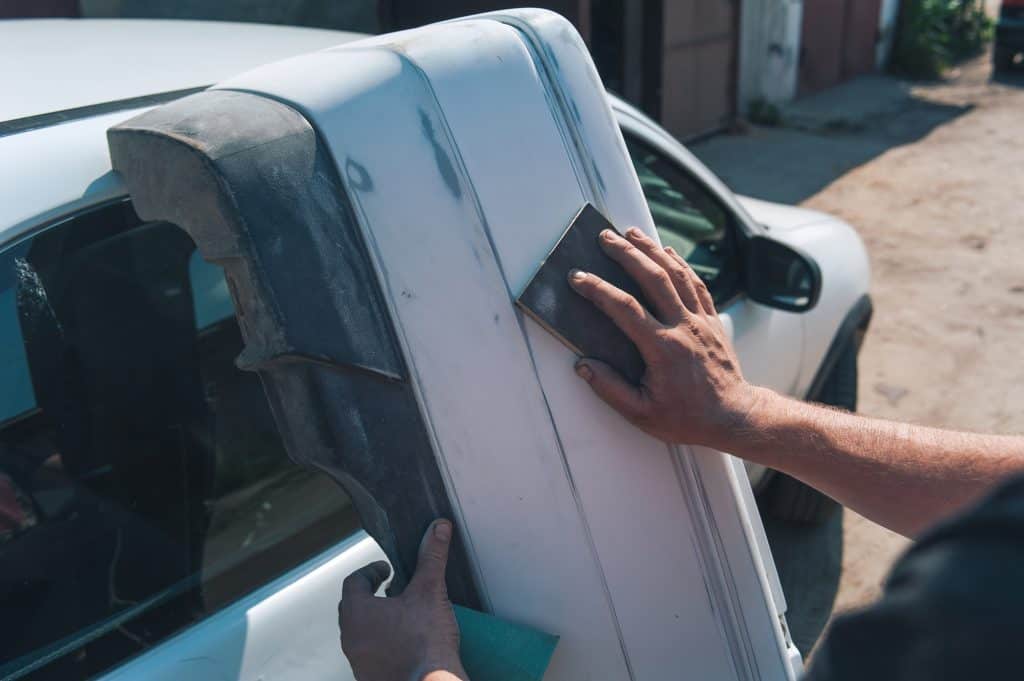Sandpaper is an integral part of any DIY or home improvement fans’ toolbox. It’s helpful to smooth out wood, prepare a surface for painting, and even polish plastic. As plastic is a flexible, reasonably fragile material, it is important to know how to sand plastic.
It is best to use wet sandpaper on plastic to prevent scratches. Gently rub at the plastic using irregular circular motions and then wipe it down with detergent once you are done sanding it. It is best to use fine-grit sandpaper (between 180-600).
This article explores everything you need to know about sanding plastic, from the step-by-step process to the type of sandpaper you should use.
Can You Sand Plastic? Yes – And Here’s How
You can sand plastic using fine-grit sandpaper that has been immersed in water. When sanding plastic, you should gently rub it in a circular motion to prevent it from scratching.
There are several reasons you may want to sand plastic:
- To restore the appearance of plastic. Like wood, plastic furniture and other equipment may get damaged and worn down when used frequently. You can sand down hard plastic to restore its appearance (source: Hunker).
- To apply paint. If you plan to paint plastic, it’s best to sand it down to make the plastic surface a little rougher. Plastic is naturally smooth, but sanding it will better help the paint adhere to it.
- To remove paint. Sanding down plastic may also help you remove paint without damaging the plastic under it.

Tips on Sanding Plastic Without Scratching It
Plastic is a relatively fragile material and is vulnerable to getting scratched. Sanding down plastic incorrectly can cause scratches on it. To ensure you don’t scratch the plastic, wet sand it using fine-grit sandpaper.
Wet sanding is the process of using sandpaper that has been immersed in water. It’s gentler on the sand material and less likely to cause scratches (source: Smithsonian Institution Scholarly Press). To wet sand plastic, you’ll need to use a particular type of sandpaper.
To properly sand plastic without scratching it, follow these steps:
- Clean the plastic with a detergent solution. If the plastic is especially dirty, use a solution of water and vinegar (1:1) with a gentle cloth.
- Begin wet sanding with sandpaper of moderate coarseness, with a grit between 180-600.
- Wipe down the plastic with a cloth and water.
- Sand down the plastic with low coarseness (800-1200 grit) sandpaper.
- Once you’ve sanded the plastic to your satisfaction, wipe it down with a wet cloth. You may also want to cover the plastic with a clear polish.
While it’s best to use wet sandpaper to sand down plastic, you can also use dry sandpaper. Use fine-grained dry sandpaper and follow the same steps outlined above.
To make sure you don’t scratch the plastic, here are some other tips:
- Keep the sanding movements irregular. When sanding plastic, move the sandpaper in irregular patterns to prevent deep set scratches from emerging.
- Use a foam block. A sanding sponge or sanding foam block will give you better control over the sandpaper, allowing you to prevent it from cutting too deep into the plastic.
- Sand in a circular motion. Rather than sanding in lines, make sure you move the sponge in circular motions to prevent harsh lines.
- Keep the sandpaper wet. Make sure your sandpaper is constantly moist to the touch. If it dries out, it may scratch the plastic – you can spray water on it or use a new patch of sandpaper.
Here are some popular brands and types of sandpaper used for wet sanding plastic. These are all available on Amazon.com and can be delivered directly to your door:
- Lanney Assorted Sandpaper. This is a cost-effective pack of sandpaper with various grits from 120-3000. It’s cut to be wrapped over a sanding block and will work well on plastic.
- Miady Assorted Sandpaper. This is another versatile pack of sandpaper with grits varying from 120-5000. They’re suitable for buffing and polishing plastic.
How Do You Sand Paint off Plastic?
You can sand the paint off plastic using a medium- to fine-grit wet sandpaper. However, you should make sure not to sand lead paint off plastic as the lead paint dust can be toxic to breathe in.
Here are step by step instructions for sanding paint off plastic:
- Prepare the plastic. Immerse a cloth in a gentle detergent and wipe down the plastic, scrubbing off any dirt.
- Prepare the sandpaper. Immerse your sandpaper in water and allow it to sit for a few minutes.
- Rub the sandpaper over the plastic, using a back and forth motion. Continue doing this until the paint starts to chip away. The back and forth motion will ensure that the paint is chipped away evenly.
- Once the paint is removed, wipe the plastic with a detergent solution and dry.
Which Grit Should I Use To Sand Plastic?
Using fine-grit sandpaper to sand plastic prevents scratches. It’s best to use sandpaper that’s between 180-600. You can use finer grit when preparing plastic for painting. If you’re trying to remove paint from plastic, you may use a coarser grit.
Can You Sand Plastic Without Sandpaper?
In some instances, you may find that you need to sand down plastic without having sandpaper on hand. While sandpaper is the best tool to use, you may be able to smooth plastic with other materials like toothpaste and baking soda (source: Real Homes).
Here’s a closer look at some of the materials that can act as a substitute for sandpaper:
- Toothpaste. Press toothpaste onto a microfibre cloth and rub at the plastic in circular motions. It will help remove any tiny scratches on the plastic.
- Baking soda. Mix equal baking soda and water parts and dip a microfiber cloth into the mixture. Use circular motions to rub at the plastic and wipe it with a wet cloth once you’re done. This method is ideal for making sure paint adheres to the plastic better.
- Heat Guns. If you need sandpaper to remove stains or marks on plastic, you can use a heat gun to do the same. Put a heat gun on its lowest setting and then run it lightly over the plastic.
You will see that the plastic looks shinier once it cools down. Be sure not to turn the setting any higher as it may burn, melt or otherwise damage the plastic. - Vinegar. If you want to remove stains on the plastic, you don’t need to sand it down. Instead, mix a tablespoon of white vinegar with a cup of water and soak the plastic in this solution for a few hours to lift the stain.
Can You Sand ABS Plastic or Not?
As well as sanding down furniture and household objects, you may also want to sand down 3D plastic prints. ABS plastic is one of the most accessible 3D printing materials to sand. Start with medium-grit sandpaper and then move up to a more fine-grit one.
Sanding down ABS plastic will remove the layer lines on the 3D print and help smooth it down. Sanding will also help prepare the ABS plastic for painting.
Here are the steps to sanding down ABS plastic:
- Allow the plastic to become completely dry and firm.
- Begin with sanding the plastic using 200 grit sandpaper. Focus on the stepping lines.
- Continue sanding down the plastic with 600 grit sandpaper.
- Continuously monitor the ABS print while sanding it to avoid changing the dimensions or the core structure of the print.

How Do You Sand a Plastic Car Bumper Before Painting?
Another common object that people sand down is their car bumpers. Using sandpaper on a plastic car bumper prepares it for painting and restoration, which can give your car a whole new look. It’s best to wet sand your bumper with very fine-grit sandpaper.
Here’s how to sand your plastic car bumper before you paint it:
- Remove the plastic bumper from your car.
- Wash the bumper with a detergent and degreaser using a cloth to scrub off any dirt.
- Affix the plastic bumper on a secure surface so you don’t have to handle it by hand.
- Use 600 grit wet sandpaper and rub it in alternating straight lines and spray the bumper with water every few minutes.
- Keep sanding until you feel like all the rough spots on the bumper have been smoothed out.
- Once you have finished sanding it, use a wet cloth to rub the bumper clean.
- Allow the bumper to dry before you begin painting.
- Spray the bumper with a paint primer. Make sure you use a primer that has been designed for plastic like Dupli-Color CP199 Clear Adhesion Promoter Primer. This is a great primer because it’s quick drying and has been specially designed for automotive parts.
- Sand the bumper with dry 800 grit sandpaper to smoothen over any bumps that may have cropped up in the primer stage.
- Spray the bumper with the paint, applying a second coat if necessary. Allow it time to dry and then reinstall it onto your car. (source: SuperCheap Auto)
- (source: Popular Mechanics).
Conclusion
You can easily wet-sand plastic if you use medium- to fine-grit sandpaper. Be sure to always have high-quality sandpaper in your toolbox if you often work with plastic!












